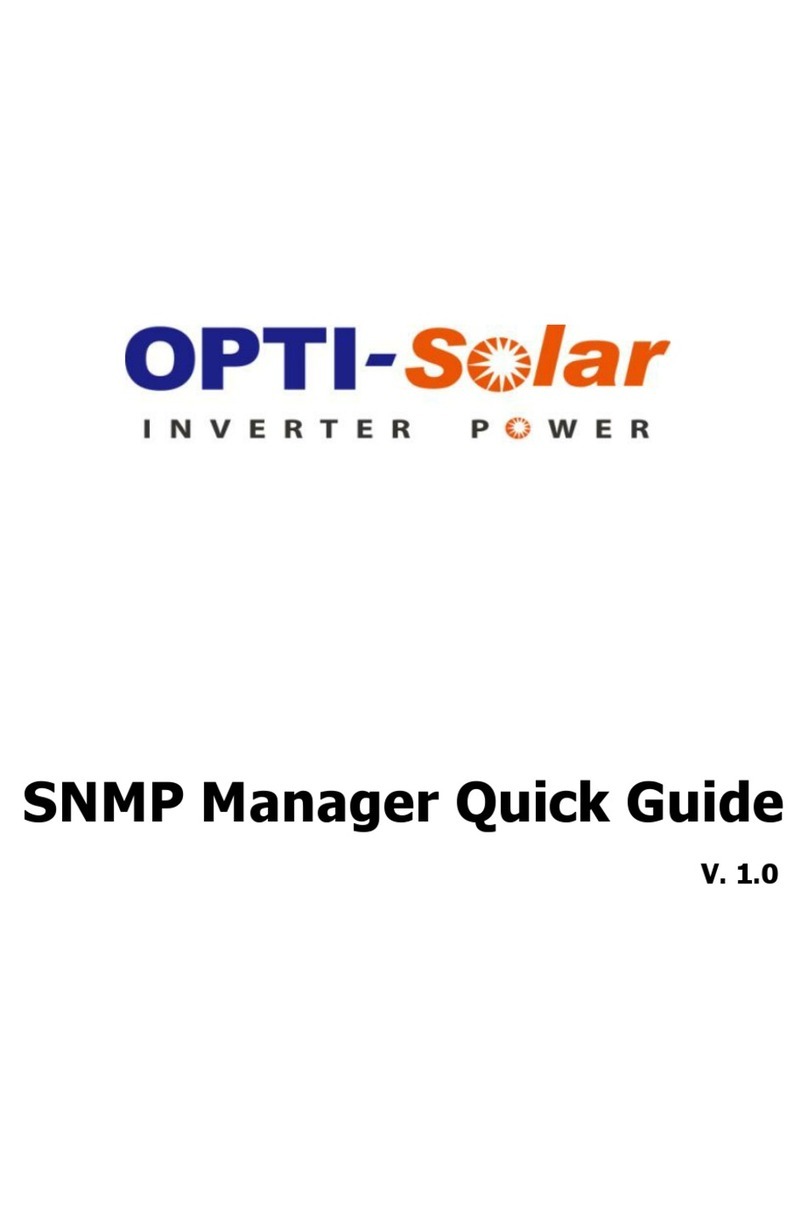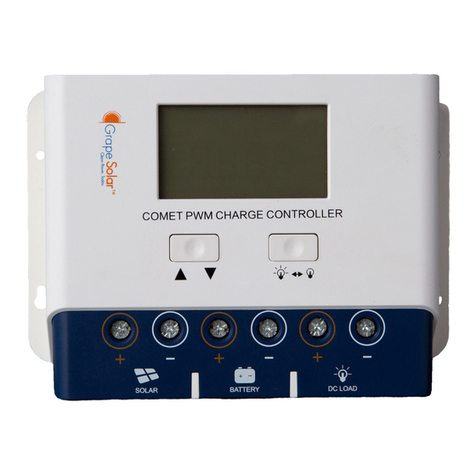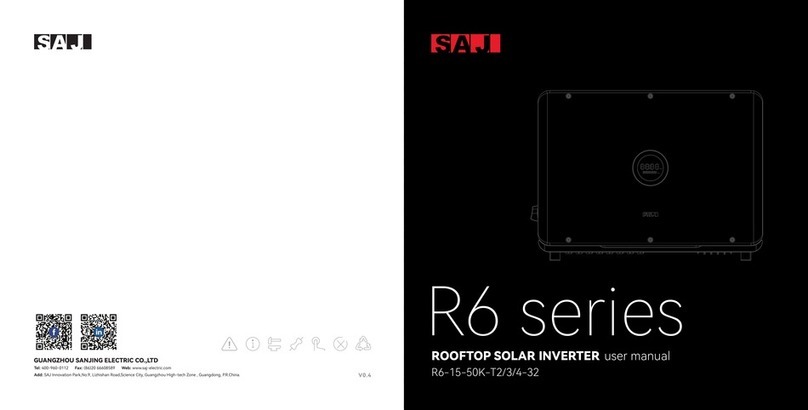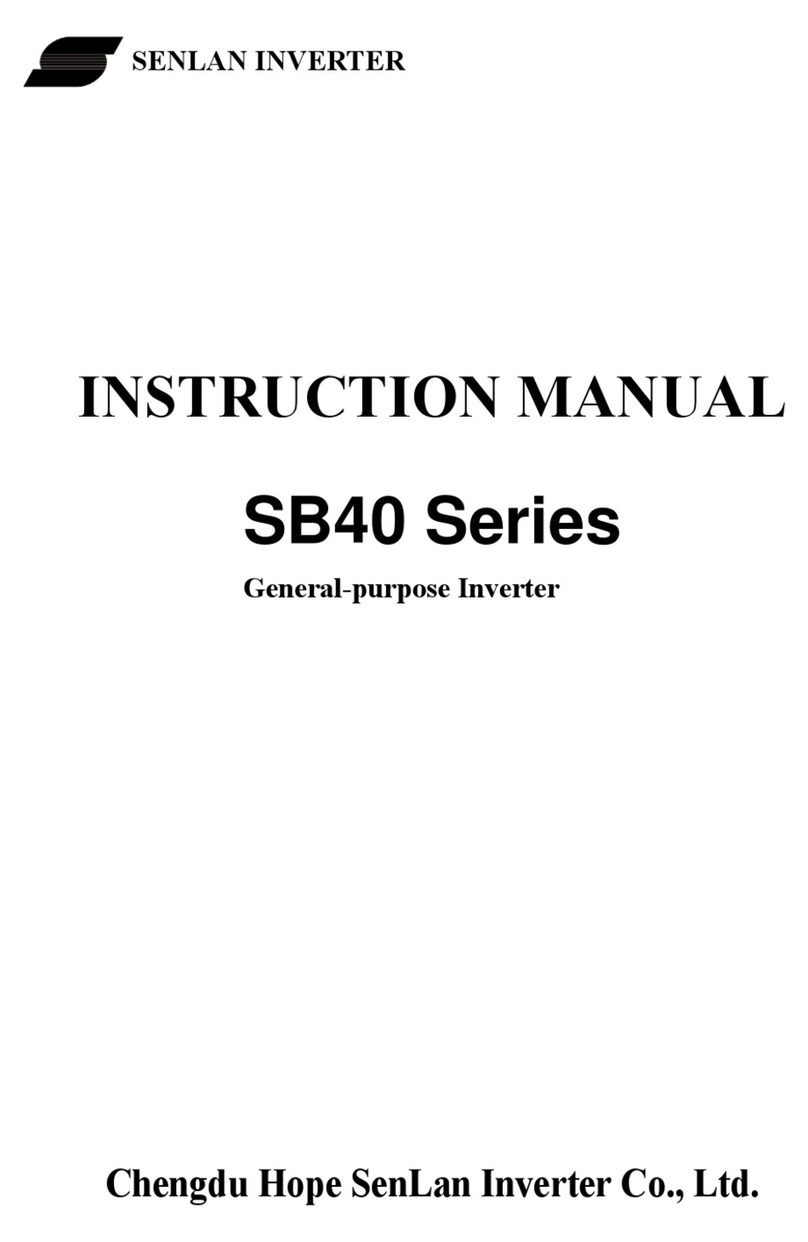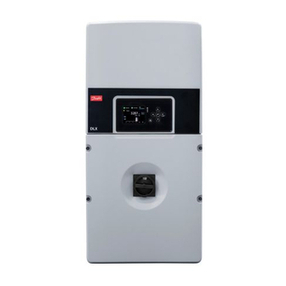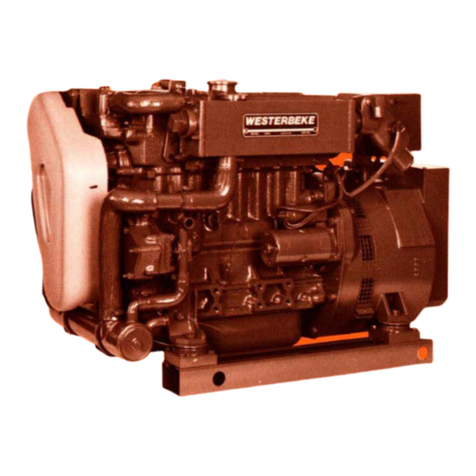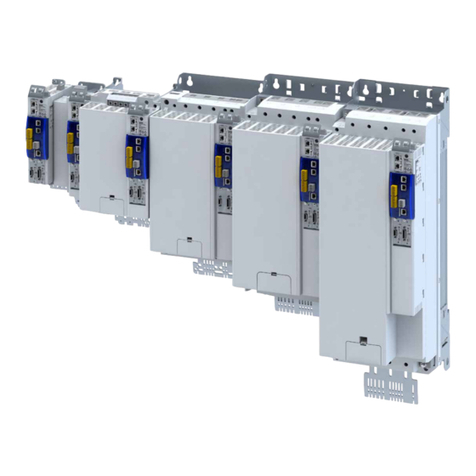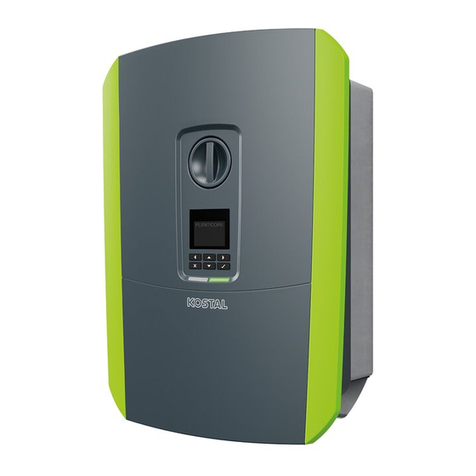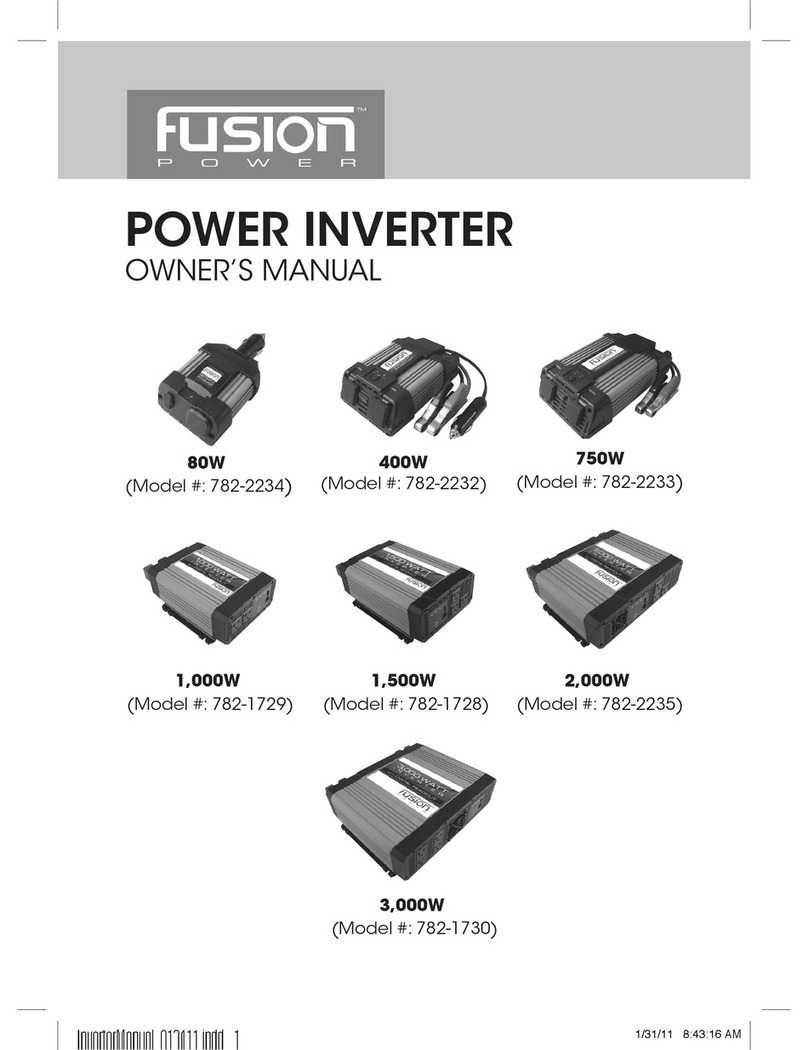Seeley Braemar Invertair SACV10D1S User manual

INSTALLATION MANUAL
Braemar Invertair™- True Inverter Add-On Cooling Unit
Original English Instructions
(English) (InvertairTM)
SACV10D1S / SCHV10D1S
SACV12D1S / SCHV12D1S
SACV14D1S / SCHV14D1S
SACV16D1S / SCHV16D1S

2 |Invertair™ - True Inverter Add-On Cooling Unit
CHECKING RECEIVED PRODUCT
Upon receiving the appliance, please inspect for damage.
Claims for damage should be reported immediately with
the transportation company. Check the model number
of the appliance and ensure it matches the order. In the
event an incorrect appliance or a damaged appliance
is delivered, it must be returned to the supplier and
must NOT be installed. The manufacturer assumes no
responsibility for installation of incorrectly delivered
appliance and/or damaged appliance.

SEELEY INTERNATIONAL - INSTALLATION MANUAL |3
TABLE OF CONTENTS
BEFORE YOU START 4
CHECKING RECEIVED PRODUCT 4
BEFORE INSTALLATION 4
OVER-CURRENT PROTECTION 4
REFRIGERANT TUBING 4
INSTALLER AND MAINTENANCE CONTRACTORS 4
RISK ASSESSMENT 4
SOME POINTS TO CONSIDER: 4
MOST COMMON CAUSES OF POOR COOLING PERFORMANCE 5
TROUBLESHOOTING 6
DUCTED GAS HEATER - ADD-ON COOLER COMBINATION TABLE 6
TYPICAL INSTALLATION / DIAGRAM OF KEY COMPONENTS 7
INDOOR COOLING COIL UNIT DIMENSIONS 7
CONSIDERATIONS WHEN CHOOSING A LOCATION: 7
THERMISTOR INSTALLATION 9
DUCT CONNECTIONS 9
FLEXIBLE DUCTWORK CONNECTIONS 10
OUTDOOR UNIT INSTALLATION 11
OUTDOOR CLEARANCES 11
OUTDOOR DIMENSIONS 12
REFRIGERANT PIPE-WORK 13
VERTICAL/HORIZONTAL PIPE-WORK 13
BRAZING 13
FLARING 13
PIPE-WORK 13
CONNECTION BETWEEN INDOOR UNIT AND OUTDOOR UNIT 14
CONDENSATE DRAIN PIPE 15
CONDENSATE DRAIN PIPE INSTALLATION 15
ELECTRICAL WIRING 16
MAINS & CONTROL WIRING 16
ELECTRICAL SHOCK CAN CAUSE PERSONAL INJURY OR DEATH 16
WIRING PRECAUTIONS 17
WIRING SCHEMATICS: HEATER TO INDOOR TO OUTDOOR CONNECTION 17
WIRING INDOOR UNIT SIDE 18
WIRING OUTDOOR UNIT SIDE 18
MAGIQTOUCH CONTROLLER SET UP 19
GAS DUCTED HEATER & INVERTAIR™ INVERTER ONLY 19
GAS DUCTED HEATER ZONES & INVERTAIR™ INVERTER 19
MAGIQTOUCH CONTROLLER CONFIGURATION 20
ADDING INVERTAIRTM INVERTER TO NEW SYSTEM 20
ADDING INVERTAIR™ INVERTER TO AN EXISTING MAGIQTOUCH INSTALLATION 20
START & COMMISSIONING 23
ERROR CODES 24
BRAEMAR REFRIGERATED AIR CONDITIONING - COMMISSIONING SHEET 25
TECHNICAL SPECIFICATION 26
REMOVAL AND DISPOSAL 27
WARNING! Failure to install and commission the product in compliance with these instructions, or failure to do the job properly and compe-
tently, may void the customer’s warranty. Further, it could expose the Installer and/or the Retailer to serious liability.

4 |Invertair™ - True Inverter Add-On Cooling Unit
Installation training is available from Seeley International for
qualied and licensed installers; please contact your local ofce
for training dates.
CHECKING RECEIVED PRODUCT
Upon receiving the appliance, please inspect for damage.
Claims for damage should be reported immediately with the
transportation company. Check the model number of the
appliance and ensure it matches the order. In the event an
incorrect appliance or a damaged appliance is delivered, it
must be returned to the supplier and must NOT be installed.
The manufacturer assumes no responsibility for installation of
incorrectly delivered appliance and/or damaged appliance.
BEFORE INSTALLATION
The installer should read all instructions carefully prior to
installation, and ensure that every step described in this manual
is understood and taken into account before starting installation.
The appliance must only be installed by a qualied, licensed
installer.
Proper installation will help ensure trouble free operation.
Improper installation may result in problems such as noisy
operation, compressor damage, improper operation or dangerous
conditions that could result in injury or property damage or void
the warranty.
OVER-CURRENT PROTECTION
Over-current protection which is less than what the manufacturer
recommends could result in unnecessary fuse failure and a
chargeable service call. The manufacturer bears no responsibility
for damage caused to the equipment as a result of deviation
from the recommended rating.
REFRIGERANT TUBING
Keep refrigerant tubing clean and dry prior to and during
installation to avoid equipment damage. Tubing MUST
comply with all relevant local, state and national standards.
IMPORTANT! The Australian greenhouse ofce has issued
various regulations on the use and disposal of refrigerants in
the appliance. Failure to follow these regulations may harm the
environment and could lead to the imposition of substantial
nes.
Only qualied and licensed technicians should install this
appliance, failing which the warranty on the appliance will be
void.
INSTALLER AND MAINTENANCE CONTRACTORS
A risk assessment is an essential element that should be
conducted before the commencement of work, to identify
and eliminate the risk of falls or to minimize these risks by
implementing control measures.
BEFORE YOU START
RISK ASSESSMENT
A risk assessment of all hazardous tasks is required before
commencing any work, and may be required under legislation.
There is no need for this to be a complicated process, it just is
a matter of looking at the job to be done and considering what
action(s) are necessary so the person doing the job does not
injure themselves.
This should be considered in terms of:
• What are the chances of an incident happening?
• What could the possible consequence be?
• What can you do to reduce, or better still, completely get rid of
the risk?
SOME POINTS TO CONSIDER:
• What is the best and safest access to the roof and working
areas?
• If a worker is alone, who knows they are there and if they get
into difculty, how can they summon help? (Call someone on
the ground? Mobile phone? etc.)
• What condition is the roof in? Should the trusses, underside or
surface be checked?
• Does the worker have appropriate foot wear?
• Are all power cables/extension leads safe and appropriately
rated?
• Are all ladders, tools and equipment suitable in good
condition?
• Where ladders are to be used, is there a rm, stable base for
them to stand on? Can they be tied or secured in some way
at the top? Is the top of the ladder clear of electricity supply
cables?
• Is there a roof anchor to attach a harness and lanyard to? If
so, instruction should be issued for the use of an approved
harness or only suitably trained people used.
• Are all tools and materials being used, prevented from slipping
and falling onto a person at ground level? Is the area below the
work area suitably protected to prevent persons walking in this
area?
• Does the work schedule take into account weather conditions,
allowing for work to be suspended in high winds, thunder
storms/lightning or other types of weather giving wet, slippery
surfaces?
• Is there an on-going safety check system of harnesses, ropes,
ladders and access/lifting equipment and where they exist on
roofs, anchor points before the commencement of work?
• Is there a system which prevents employees from working
on roofs if they are unwell or under the inuence of drugs or
alcohol?
• Are there any special conditions i.e. Excessive roof pitch,
limited ground area, fragile roof, electrical power lines?
This Invertair™ True Inverter Add-On Cooling unit is to be
installed indoor in the roof space and shall only be performed
by suitably trained and qualied personnel, in accordance with
local and national wiring rules.

SEELEY INTERNATIONAL - INSTALLATION MANUAL |5
MOST COMMON CAUSES OF POOR COOLING PERFORMANCE
Issue Cause & Description Page No.
Neglecting to use the Braemar
transitions for the DGH and/or
AOC
The Braemar transitions are specically designed to
ensure the maximum amount of air is available through
the compact TQ/TQM extra air series, and the correct
amount of air is distributed evenly through the cooling coil,
maximising efciency and performance.
8 - 10
Duct sensor positions
The duct sensor measures the air temperature in the duct
for both heating and cooling. This measurement is used to
control the gas burner rate during heating, and, as a low
temperature protection in cooling to prevent the indoor coil
from freezing.
8 - 9
Ductwork
Incorrectly sized or poorly designed duct can have a
disastrous effect on the cooling and heating performance.
Whilst it is best to keep duct runs as short as possible, it is
also advisable to have at least 3m of duct connected to any
grille or diffuser. However, if longs runs are unavoidable,
please ensure to upsize them accordingly.
Ensure the duct between the DGH and the Cooling coil are
as straight and short as possible.
8 - 10
Airow
The air is what carries the cooling and/or heating to
any area that is being conditioned. Without the correct
amount of air to any area, that area will suffer from under
conditioning.
Please ensure ductwork is designed to carry the required
amount of air for proper cooling and heating.
The fan speed has been selected to suit that amount of air
for that area. If zoned, the zoning is adjusted and checked
to ensure it is commissioned correctly.
8 - 10
Return Air Position
If the return air is located outside of the conditioned
area, the system will need to run longer to provide the
required amount of heating or cooling. This is due to the air
temperature of the non-conditioned area being higher (in
cooling) or lower (in heating) and the equipment needing to
provide more energy to achieve the result.
Refer TQ/TQM
Installation Manual
Thermostat Position
The position of the thermostat will dictate how satised
the user will be. It is at this point where the temperature
is measured and if the thermostat is not in the conditioned
space, there is a chance the conditioned space will always
be at a different temperature to that set on the thermostat.
Refer TQ/TQM
Installation Manual
Outdoor unit
Check clearances, x the unit in position, use rubber feet
as supplied. Check installation position does not breech
maximum or minimum eld installed pipe lengths.
Check the refrigerant charge matches the eld installed
pipe length.
Ensure the pipe work is installed as required, including use
of oil traps if required.
11 - 13
Electrical
Ensure correct cable and circuit breaker are used. Power
cable sizes are recommended only; AS/NZS 3000 and all
local, state and national codes must be adhered to.
16 - 18
Commissioning Complete the commissioning data checklist. 25

6 |Invertair™ - True Inverter Add-On Cooling Unit
TROUBLESHOOTING
Symptom Cause Action
The air conditioner does not
run
Power failure. Wait for power to resume.
Fuse blown or circuit breaker open. Replace the fuse or reset the breaker.
Voltage is too low. Find the cause and x it.
Electrical connections loose. Retighten the connection.
Thermostat adjustment too low (in heating
mode) or too high (in cooling mode). Check thermostat setting.
Incorrect wiring terminal loose. Check and retighten.
There is insufcient cooling
There is a gas leak. Remove charge, repair, evacuate and
recharge.
Liquid and gas line insulated together. Insulate them separately.
The room was probably very hot when you
started the system.
Wait a while so unit has enough time to
cool the room.
The compressor runs
continuously
Thermostat adjustment too high (in heating
mode) or too low (in cooling mode). Check and adjust thermostat set point.
Poor Airow.. Ensure duct and lters are clean and
unobstructed. Check fan speed setting.
Refrigerant charge too low, leak.
Repair, evacuate and recharge. Check pre-
charge length and add required additional
refrigerant.
Air or incondensable in refrigerant circuit. Remove charge, repair, evacuate and
recharge.
The compressor starts but
shuts down quickly Blocked expansion device or closed valves Check for blocked EXV, check for closed
section valve 6.
‘Clicking’ sound is heard from
the air conditioner.
In heating or cooling operation any plastic
parts may expand or shrink due to a
sudden temperature change in this event, a
clicking sound may occur.
This is normal
NOTE: If installation is correct and issues still exist, please contact the warranty department.
DUCTED GAS HEATER - ADD-ON COOLER COMBINATION TABLE
Indoor Unit Outdoor Unit MIN-RATED-MAX
Cooling (kW)
Airow (l/s)
Applicable Braemar “TQ”
Ducted Gas Heater
Transition Kit
(Dimensions)
Max Fan
SACV10D1S SCHV10D1S 3.20 - 10.00 - 11.00
330 - 550 - 650 X20, X23
645513
(945 x 290 x 400Ø) 10
SACV12D1S SCHV12D1S 4.00 - 13.00 - 13.50
415 - 610 - 800
645513
(945 x 290 x 400Ø) 10
SACV14D1S SCHV14D1S 6.00 - 14.50 - 14.50
470 - 700 - 800 X23, X25 645513
(945 x 290 x 400Ø) 10
SACV16D1S SCHV16D1S 6.40 - 15.50 - 17.00
610 - 1050 - 1070 X30, X32 645520
(1110 x 290 x 450Ø) 10

SEELEY INTERNATIONAL - INSTALLATION MANUAL |7
TYPICAL INSTALLATION / DIAGRAM OF KEY
COMPONENTS
INDOOR COOLING COIL UNIT DIMENSIONS
Indoor and Outdoor unit operating temperature range:
Dimension (mm)
Model A Supply Air Return Air B C
D E F G
SACV10D1S 366 290 946 290 946 450 1280
SACV12D1S 366 290 946 290 946 450 1280
SACV14D1S 366 290 946 290 946 450 1280
SACV16D1S 412 290 1110 290 1110 435 1442
CONSIDERATIONS WHEN CHOOSING A LOCATION:
Select a location by choosing a place:
• That is easy for refrigeration piping and condensate drainage
• That can carry the added weight of the appliance
• Which has easy access for maintenance
• Which should not be near any heat source or moisture
• Where water is easily drained out
• Where duct connections can be made with ease
Additionally consider:
• Ensure duct thermistor is placed downstream of indoor coil
• Ensure duct from heater to coil is as straight as possible
• Ensure return air duct is sized accordingly
TYPICAL ADD-ON COOLING COIL
TYPICAL OUTDOOR UNIT
Indoor Unit Outdoor Unit
18°C - 30°C -15°C - 48°C

8 |Invertair™ - True Inverter Add-On Cooling Unit
INDOOR COOLING COIL UNIT DIMENSIONS cont.
Indoor Unit Kit number
SACV10D1S 645513
SACV12D1S 645513
SACV14D1S 645513
SACV16D1S 645520
1.5 to 2.5
METRES
RETURN
Air Duct
Cooling Coil
SUPPLY
Air Duct
COOLING THERMISTOR IS
INSTALLED AT THE
OUTLET OF THE COOLING COIL
HEATING THERMISTOR IS
INSTALLED AT THE INLET OF
THE COOLING COIL
It is a requirement that Seeley
supplied duct transitions must
be used! (To ensure good even
airow across the coil.)
Return air connection is
NOT permitted on the motor
side of the fan assembly!
ILL1992-C
MAKE SURE THE COOLING COIL IS INSTALLED WITH AIRFLOW IN THE DIRECTION AS SHOWN ON THE DECAL ON THE UNIT.
• The cooling coil can be mounted on a suitable base. Ensure that the base is level and that the drains are free to be piped correctly
with enough height to allow for condensate trap and fall to waste.
Alternative method – hanging from above.
• Measure and mark the position for the suspension bolts or rods. Be sure the position does not interfere with anything and there is
sufcient height to allow for adequate drainage from the unit.
Extra Air heaters with MAGIQTOUCH Controller are designed for use with Braemar InvertairTM True Inverter Add-On Cooling units.
• These models must have “Q” in their part number.
• These models include an “X” in their model numbers, eg, TQ4X30 and TQ5X32. The following points must be taken into account to
ensure correct operation of both the refrigerated cooler and the heater.
• Ensure that the refrigerated cooling unit is sized correctly to suit the house and the heater.
• To prevent excessive air ow restriction, the ducting between the heater and the cooling coil should be as straight as possible. If
bends are required, use the largest bend radius possible.
• A correctly-sized low level return air grille with a lter MUST be tted when installing Braemar Invertair™ - True Inverter Add-On
Cooling unit – refer table on page 10 as a guide.

SEELEY INTERNATIONAL - INSTALLATION MANUAL |9
ILL1993-A
LEGEND
1 - Place louvre inll panel (A) on air outlet end of heater.
2 - Place plain inll panel (B) on air inlet side of heater.
3 - Attach heater transition assemblies (C) to heater. Return must be connected to non-motor side of the fan as shown.
4 - Square sides of transitions and secure with self drilling screws supplied in kit.
Attach panels and transitions to heater - as supplied in Kit.
DUCT CONNECTIONS
THERMISTOR INSTALLATION
Must be installed:
• In the supply air duct in a common air ow- this is an airow that is not zoned
• Installed centrally at the top of the duct
• The heating thermistor is installed at the inlet of the cooling coil
• The cooling thermistor is installed at the outlet of the cooling coil
COOLING COIL INSTALLATION
• To be installed within 1.5 to 2.5 metres from the heater supply air outlet
• To be installed at the same height as the heater supply air outlet
• The ducting between the heater and coil should be straight and provide no resistance to airow.
Cooling Coil
Heater
Heater
Cooling Coil
Heater Cooling Coil
INDOOR COOLING COIL UNIT DIMENSIONS cont.

10 |Invertair™ - True Inverter Add-On Cooling Unit
INDOOR COOLING COIL UNIT DIMENSIONS cont.
Recommended Duct Sizes Refrigerated Cooling
and Gas Ducted Heating Only
Duct Description Main
Duct
Branch &/or Return
Duct Final Duct
Max. Velocity (m/s) 6.0 4.1 3.0
Flexible Duct Size
(mm) Duct Capacity (L/S)
150 - - 52
200 - 140 100
250 300 220 150
300 420 300 210
350 600 440 300
400 750 510 380
450 960 670 480
500 1200 850 600
550 1400 1000 700
600 1700 1200 850
Note! As per Ducted Gas Heater Installation Manual
• If duct run exceeds 6m, increase the full length by 50mm
• If duct run exceeds 9m, increase the full length by 100mm
DEFINITIONS:
• Main Duct – the duct that connects directly to the appliance.
• Branch Duct – the duct section that connects the Main Duct to
a Final Duct.
• Return Duct – the duct that connects the return air grille to the
appliance.
• Final Duct – the duct that connects directly to an outlet or
diffuser.
Heater
Model Indoor Coil
Minimum
airow
(l/s)
Rated
airow
(l/s)
Duct Connection
Sizes*
Min
Return Air
Filter Size
(m2)
Suggested minimum dimension
(mm)
ABC
X20, X23 SACV10D1S 275
550
400 400 400
0.32 400 x 800
X20, X23 SACV12D1S 305
610
400 400 400
0.38 400 x 950
X23, X25 SACV14D1S 350
700
400 400 400
0.48 400 x 1200, 600 x 800
X30, X32 SACV16D1S 525
1050
450 450 450
0.58 400 x 1500, 600 x 1000
*Refer locations A, B, C page 7 - Duct connection sizes do not dictate the required duct size.
*To calculate unknown dimension, divide the “Min return air lter size” by an available dimension. For example, you are installing the
SACV16D1S and you have a clearance of 450mm between studs, Min return air lter size is 0.58m², divide this by 0.45m and the
required length/height is 1.28m.
FLEXIBLE DUCTWORK CONNECTIONS
• It is important that all ductwork be tted securely and with airtight connection.
• Use the supplied square to round transitions for proper and even air ow through the heater. It is strongly recommended to use inlet
and outlet transitions for the Indoor Coil, as supplied.
• For exible duct to transition, unit or outlets, provide a mechanical connection using strapping or banding in addition to duct tape
for air seal. Do not rely on tape only.
• Ductwork should be adequately sized to suit the heater and installation to prevent excessive back pressure.
• Duct run > 6m, increase the full length of the duct run and spigot diameter by 50mm
• Duct run > 9m, increase the full length of the run and spigot by 100mm.
• Ductwork should be adequately supported and free from air leaks.
Heater
model Indoor Unit Minimum
Airow (l/s)
Minimum
number of
open outlets
200mm dia.
X20, X23 SACV10D1S 275 3
X20, X23 SACV12D1S 305 3
X23, X25 SACV14D1S 350 4
X30, X32 SACV16D1S 525 6

SEELEY INTERNATIONAL - INSTALLATION MANUAL |11
OUTDOOR UNIT INSTALLATION
A~E Hb, Hd, H (mm)
a b c d e
B- - ≥100 - - -
A, B, C - ≥300 ≥100 ≥100 - -
B, E - - ≥100 - - ≥1000
A, B, C, E - ≥300 ≥150 ≥150 - ≥1000
D- - - ≥1000 -
D, E - - - ≥1000 ≥1000
B, D Hb<Hd Hb>H - ≥100 - ≥1000 -
Hb<Hd Hd<H - ≥100 - ≥1000 -
B, D, E
Hb<Hd
Hb≤1/2H - ≥250 - ≥2000 ≥1000
1/2H<Hb ≤H - ≥250 - ≥2000 ≥1000
Hb>H Prohibited
Hb>Hd
Hd ≤1/2H - ≥100 - ≥2000 ≥1000
1/2H<Hd ≤H - ≥200 - ≥2000 ≥1000
Hd>1/2H Prohibited
OUTDOOR CLEARANCES
• Bends in exible ductwork should be as smooth as possible and with a minimum radii of 2 duct diameters.
• Duct should be at least R1 insulated.
• All exible duct should be extended and trimmed to length. If a 6m length is compressed to 5m instead of trimming to length. A
doubling of the duct resistance is created.
• The return air duct should be a minimum of 3m and include one change of direction, to minimise noise transfer from the heater
fan.
• For servicing, a minimum clearance of 600mm must be provided in front of the access panel side of the unit for its entire length.
Important Notes:
1. Ensure that a minimum of 2 1/2 times the duct diameter of straight ductwork is installed, immediately downstream of the Indoor
unit before any divergence or branch-take offs.
2. Fill and test drain before running the system.
Air deectors allow a reduction in the clearance "d" and they can be purchased from Seeley International, refer to the Technical
Specication table on page 26. Please contact Seeley International for further advice.

12 |Invertair™ - True Inverter Add-On Cooling Unit
Outdoor Model A B C D E
SCHV10D1S 1107 440 1100 631 400
SCHV12D1S
SCHV14D1S 1085 427 1365 620 395
SCHV16D1S
OUTDOOR DIMENSIONS
ILL1995-A
D
A
B
C
E
Location considerations:
• Most importantly, do not install the Outdoor unit where there is a possibility it will cause a noise complaint from neighbours.
Be mindful of the environment. Installers must comply with noise regulations and operating sound levels conform to local
requirements.
• Allow sufcient clearances for maintenance around the unit. (Refer ILL1994-A).
• Be well ventilated, so that the unit can draw and distribute sufcient air.
• Be capable of bearing the weight of the Outdoor unit whilst also isolating noise and vibration. See the technical section of this
booklet for weights and dimensions.
• Use suitable rubber/wafe vibration isolators under mounting feet
• Fix unit in position to ensure it is kept upright
• Wherever possible protect the unit from direct sunlight.
• When installing by the seaside remember to make allowances to have the unit washed down to protect against the salt spray.
• Allow for drainage of rainwater.
• Not discharge air towards the prevailing wind. This may stall the condenser fan.
• Ensure air discharge and operating sound levels conform to local requirements.
• Not be susceptible to dust or oil mist.
• Ensure intake air temperature is no higher than ambient temperature. (Max. 48°C)
• Allow proximity to Indoor Coil – Minimum 3m, Maximum 50m pipe length (Refer Refrigerant Pipe-Work section page 13).
OUTDOOR UNIT INSTALLATION cont.

SEELEY INTERNATIONAL - INSTALLATION MANUAL |13
REFRIGERANT PIPE-WORK
WARNING! Indoor coil is pressurised with dry nitrogen, release pressure by depressing red button on indoor pipe connection cap.
If no pressure is present, coil may be damaged, please pressure test before installing.
Pipe-work must be installed in a manner which prevents drainage of liquid into the compressor, and ensures adequate oil return.
Pipes should be at least 3m in length, incorporating at least two direction changes. This will reduce transmission between Indoor and
Outdoor units.
Pipe-work is to be installed according to the Current Code of Good Practice for Refrigeration and Air-conditioning.
• Select pipe-work size from Table.
• Both interconnection lines must be individually insulated (minimum 10mm thickness).
• Do not allow moisture, dust or other foreign particles to enter the pipe-work.
• Only use refrigeration grade copper tubing, suitable for R410A and to Australian Standards.
• Installed pipe-work must be pressure tested to a minimum of 2,000 KPa for at least 1 hour using dry nitrogen
• Pipe work must not be buried underneath the ground.
VERTICAL/HORIZONTAL PIPE-WORK
Maximum vertical rise is 15m (for SCHV-10),
30m (for SCHV12-16), with oil bends every 6m.
Maximum Total length of pipe-work must not exceed 50m.
BRAZING
If brazing of pipe-work is required, dry nitrogen must be used to purge the pipe-work during welding. When brazing close to the are
nuts, a wet cloth must be used to protect the valves.
FLARING
All ares must be done with a quality aring tool, suitable for R410A and refrigeration ares.
PIPE-WORK
• Select copper pipes for gas and liquid as specied for the system (refer the pipe table below).
• For dust and moisture protection, before assembly of the pipe and its insulation, both ends of the pipe must be covered.
• Avoid pipe bending as much as possible; if it is necessary to bend, the bending radius must be more than 4cm.
Model Number
Indoor / Outdoor
Pipe Sizes
Liquid / Vapour
Min., Pre, Charge,
Max., Pipe Length
SCHV10D1S / SCHV10DS
9.53 (3/8) / 15.88 (5/8)
3.0 - 7.0 - 50.0
SCHV12D1S / SCHV12DS
SCHV14D1S / SCHV14DS
3.0 - 9.5 - 50.0
SCHV16D1S / SCHV16DS
9.53 (3/8) / 19.05 (3/4)
ILL1997-A
Oil bend
Oil bend
Indoor
Outdoor
6m

14 |Invertair™ - True Inverter Add-On Cooling Unit
• Do not repeatedly bend or stretch the pipe more than 3 times. Excessive bending will break the pipe.
• Centre the pipe against the port on the indoor unit and turn by hand, prior to tightening with the torque wrench.
CONNECTION BETWEEN INDOOR UNIT AND OUTDOOR UNIT
Flare the pipe’s end with are tool, ensuring a good quality are is achieved.
Tighten are nuts onto gas pipe and liquid pipe at the Indoor unit and Outdoor unit, with two holding spanners.
Refer to the following table for are geometry and torque requirements for ensuring a sound connection.
Pipe Gauge Spanner Size
(mm)
Tightening Torque Flare Dimension
“A” Flare Shape
Nm kgf.cm Technique Min.
(mm)
Max.
(mm)
6.35mm (¼”) 17
15-30 153-306 8.3 8.7
9.52mm (3/8”) 22
35-40 357-408 12.0 12.4
12.7mm (½”) 24
45-50 459-510 15.4 15.8
15.9mm (5/8”) 27
60-65 612-663 18.6 19.1
19.0mm (¾”) 32
70-75 714-765 22.9 23.3
Pressurise the indoor unit & pipe work again with dry nitrogen and check for any joint leaks by pressurising the system to 2,000 KPa
and holding for at least an hour. Repair as necessary, but ensure the system under repair is not under pressure prior to brazing.
With the Indoor unit pressure again released, evacuate the pipe work and indoor coil to a vacuum pressure of 500 microns (65Pa)
minimum. Hold Vacuum for at least 15 minutes.
NOTE: to ensure an accurate vacuum reading, we recommend to place the vacuum gauge as far from the vacuum pump as possible.
Disconnect the vacuum pump whilst retaining the system vacuum.
Open the liquid line valve fully and then suction line valve and hold for 15 minutes.
REFRIGERANT PIPE-WORK cont.
• Always uncoil piping by unwinding from the coil - never pull the coil apart.
ILL2008-A

SEELEY INTERNATIONAL - INSTALLATION MANUAL |15
Braemar InvertairTM add on cooling units have a built in secondary (safe) tray. The drainage connection for this secondary tray
should be discharged in a visible location, not to cause nuisance, whilst complying with all state, local and national regulations.
Always install a “P” trap as close as possible to the primary tray connection point. The drain for the primary tray must be
terminated in accordance with all state, local and national regulations.
CONDENSATE DRAIN PIPE INSTALLATION
1. Rigid UPVC suitable for installations located externally (solar resistant) should be used.
2. Install pipe supports as required to prevent sagging, at no more than 1.5m intervals.
3. Some installation sites may require the drain to be insulated, these can be areas where high humidity is experienced. (Fig. 11)
4. Ensure the ‘P’ trap has a water seal depth of 50mm and the trap outlet is 50mm below the primary drain outlet
5. Fill the trap with water and check for fall (1:60 minimum)
CONDENSATE DRAIN PIPE
ILL1989-C
Clean Out
(TYP.)
Clean Out
Indoor Unit
Drain Line shall be a
minimum of 1-1/2”
Floor
Pitch Down
Toward Drain
1. Metal Clamp
2. Drain hose
3. Insulation
1 2
3
4mm
Clean Out
(TYP.)
Indoor Unit
Floor
Pitch Down
Toward Drain
100mm
50mm
100mm
50mm
Clean Out
(TYP.)
Clean Out
Indoor Unit
Drain Line shall be a
minimum of 1-1/2”
Floor
Pitch Down
Toward Drain
1. Metal Clamp
2. Drain hose
3. Insulation
1 2
3
4mm
Clean Out
(TYP.)
Indoor Unit
Floor
Pitch Down
Toward Drain
100mm
50mm
100mm
50mm
Clean Out
(TYP.)
Clean Out
Indoor Unit
Drain Line shall be a
minimum of 1-1/2”
Floor
Pitch Down
Toward Drain
1. Metal Clamp
2. Drain hose
3. Insulation
1 2
3
4mm
Clean Out
(TYP.)
Indoor Unit
Floor
Pitch Down
Toward Drain
100mm
50mm
100mm
50mm
Fig 11.
Fig 12. The eld installed drain must be no smaller than
the outlet diameter.
Drain vent height no less than height of indoor
cabinet. Fit insect mesh over open end.
Where a drain exceeds 5m horizontally, a vent may
be required, this will ensure smooth ow of water to
the discharge point.

16 |Invertair™ - True Inverter Add-On Cooling Unit
MAINS & CONTROL WIRING
WARNING! Only licensed trades persons must carry out all the wiring work. Check AS/NZS WIRING RULES for PROTECTION sizing
and cable sizes. Always refer to the relevant wiring standard for the electrical installation, and ensure the appliance is installed in
accordance with local, state and national wiring regulations.
All-pole disconnecting devices must be incorporated in the xed wiring in accordance with the wiring rules.
Some local Supply authorities have restrictions on starting current of systems. Check Authority for starting requirements for large
single-phase compressor models.
Voltage at the unit, under load conditions, must be within the range of
Single phase 230V -5% to +10%
WARNING! The insulation of the xed wiring may come into contact with hot surfaces, eg. Discharge pipe, the xed wiring insulation
must be protected and/or separated properly from the hot surface.
The minimum nominal cross-sectional area of supply cable shall be not less than shown:
ELECTRICAL SHOCK CAN CAUSE PERSONAL INJURY OR DEATH
Before start up the electrical wiring must be checked for correct terminal locations, and that power is available on each phase.
ELECTRICAL WIRING
Model
Electrical Rating
Minimum Cross-
Sectional Area of
Conductors (mm
2
)
Voltage Current Breaker
Capacity
Fuse
Capacity
SCHV10D1S
220-240/1/50
19A 25A -4.0
SCHV12D1S
220-240/1/50
21A 25A -4.0
SCHV14D1S
220-240/1/50
28A 40A -6.0
SCHV16D1S
220-240/1/50
31A 40A -6.0
Indoor
Unit
220-240/1/50
1A 3pin plug & lead
Check Testing for Required Power Supply
Power Type Terminals to Check Required Voltage Range
Single Phase A & N, A & E 220 - 240 Vac
N & E 0 Vac
* Current shown is at the Maximum test Conditions, refer below
Maximum Conditions* Cooling
Indoor Temperature 32°C DB / 23°C WB
Outdoor Temperature 48°C DB / - °C WB
Note!
1. Fuse is located on the main board.
2. Install the disconnect device with a contact gap of at least 3mm in all poles near the units (both indoor unit and outdoor unit).
The appliance must be positioned so that the plug is accessible.
3. The specications of the breaker and power cable listed in the table above are determined based on the maximum power
(maximum amps) of the unit.
4. The specications of the power cable listed in the table above re applied to the conduit-guarded multi-wire copper cable (5V-90
copper cable, consisting of PE insulted wires and a PVC cable jacket) used at 40°C and rated to 90°C (refer AS3191). If the
working condition changes, they should be modied according to the related national standard.
5. The specications of the breaker listed in the table above are applied to the breaker with the working temperature at 40°C. If the
working condition changes, they should be modified according to the related national standard.
6. Use cable size 2 x 0.75mm2 minimum as the communication lines between indoor and outdoor unit, with their longest lengths
of 50m. Please select the appropriate line length as per the actual installation conditions. The communications lines can not be
twisted together.

SEELEY INTERNATIONAL - INSTALLATION MANUAL |17
WIRING PRECAUTIONS
1. Before obtaining access to terminal, all supply circuits must be disconnected.
2. The rated voltage of the unit is as shown on previous page.
3. Always use a dedicated circuit and installed in the permanent wiring. Always use a circuit that can trip all the poles of the wiring
and has an isolation distance of at least 3mm between the contacts of each pole.
4. Perform wiring work in accordance with standards so that the air conditioner can be operated safely and positively.
5. Install a RCD in accordance with the related laws regulations and electric company standards.
6. Match the terminal block numbers and connection cable colours with those of the indoor unit side.
7. Incorrect wiring may cause burning/shorting of the electrical components.
8. Connect the connection cables rmly to the terminal block. Imperfect installation may cause damage to the unit.
9. Always fasten the outside covering of the eld installed cables with cable clamps (if the cable insulation is not clamped, electric
leakage may occur).
10. Always connect the ground wire.
HEATER ICS
OR ZONE
CONTROL
BOARD
L
L
L
L
L
CN11
H1 H2
H1 & H2 are for installer testing purposes, or non-Seeley controller connection
NOTE: Do not apply 240V to terminals 1, 2, H1, H2
RJ45 DRED
CONNECTOR
Smart
Meter
ILL2002-B
3 pin plug
3 pin plug
0.75mm2twin core communication cable connected
to low voltage terminals 1&2 supplied by installer
WIRING SCHEMATICS: HEATER TO INDOOR TO OUTDOOR CONNECTION
Connections between the Heater, the Indoor and the Outdoor units should be performed as per the below schematics.
5m communications lead supplied with InvertairTM True
Inverter Add-On Cooling unit
ELECTRICAL WIRING cont.

18 |Invertair™ - True Inverter Add-On Cooling Unit
WIRING INDOOR UNIT SIDE
Remove the electric box cover to access the connection panel.
ILL2003-B
L
CN11 Modbus communication
cable to “Cooler” connection
port on heater ICS board
1 & 2 connects to 1 & 2
at matching inverter
outdoor unit
WIRING OUTDOOR UNIT SIDE
Cable Clamps
ILL2004-B
When xing the power and communication cable, ensure they are fastened securely in place with the cable clamps provided.
CAUTION:
1. The high-voltage and low-voltage lines should enter the control box through separate rubber grommets.
2. The high voltage and low voltage lines should be xed separately and securely, using the large strain relief for high voltage and
small for low-voltage cables.
3. Tighten the indoor/outdoor connection cable on the terminal boards with screws. Faulty connection may cause a re.
4. If the indoor unit connection cable (to the outdoor unit) is wired incorrectly, the air conditioner may be damaged.
5. Position the outdoor unit power cable along the RH plate using the location hooks provided and cable ties, to ensure they are clear
of the refrigeration lines. Communication lines between indoor and outdoor units should also be positioned along the RH plate, but
ensure they do not run parallel to the power lines to avoid improper operation.
6. Ground the outdoor unit by attaching a ground wire in compliance with the applicable local and national codes.
ELECTRICAL WIRING cont.

SEELEY INTERNATIONAL - INSTALLATION MANUAL |19
MAGIQTOUCH CONTROLLER SET UP
Refer to the installation manual provided with the MAGIQTOUCH controller for instructions on installing the controller.
The Invertair™ inverter can be connected to the MAGIQTOUCH controller in a number of ways depending on the installation and
conguration.
GAS DUCTED HEATER & INVERTAIR™ INVERTER ONLY
The Invertair™ inverter is connected to either the heater ICS board or a zone control board by using the supplied 5m cable. The JST
end plugs into “CN11” on the InvertairTM board, the RJ end plugs into the “Cooler” port on the ICS board or the zone control board.
ICS
Terminal labelled
"Wall Control"
Connect RJ plug from
Invertair "CN11" to
heater ICS board "Cooler"
ILL2017-A
P/No. Description Qty
865256 LEAD ASSY 6C RJ485 5.0M 1
SPARE PARTS IF REQUIRED
GAS DUCTED HEATER ZONES & INVERTAIR™ INVERTER
For Zoned installations the Invertair™ inverter is required to be connected to the MAGIQTOUCH Zone Control module. The RJ 6 way
connector must be secured to the MAGIQTOUCH Zone Control module and the JST connector to the Invertair™ inverter.
ILL1802-D

20 |Invertair™ - True Inverter Add-On Cooling Unit
ADDING INVERTAIRTM INVERTER TO NEW SYSTEM
For a new installation refer to the MAGIQTOUCH Controller installation manual for “System Installation Wizard”, this will step you
through the complete process.
MAGIQTOUCH CONTROLLER CONFIGURATION
ADDING INVERTAIR™ INVERTER TO AN EXISTING MAGIQTOUCH INSTALLATION
The MAGIQTOUCH Controller keeps a list of all the installed components and regularly checks that all components are responding. To
add the InvertairTM inverter cooler, simply connect it to the system and power up.
Important! Ensure power is disconnected to the system while installing the InvertairTM - True Inverter Add-On cooler.
ILL2011-A
2. This menu is locked with a pin to discourage customer access. The
Pin code is 7378.
ILL1577-B
3. Select BRAEMAR INVERTER ADD – ON COOLER.
ILL2012-A
4. Once the Invertair™ Add-On Cooler has been registered
to the system the GENERAL tab will state ‘Installed’.
ILL2013-B
1. Once the system and MAGIQTOUCH controller is powered, access
SETTINGS menu and press INSTALL ADD – ON COOLER on.
Other manuals for Braemar Invertair SACV10D1S
1
This manual suits for next models
7
Table of contents
Other Seeley Inverter manuals
Popular Inverter manuals by other brands

Fuji Electric
Fuji Electric FUJI-Hydraulic FRN AR Series Starting guide
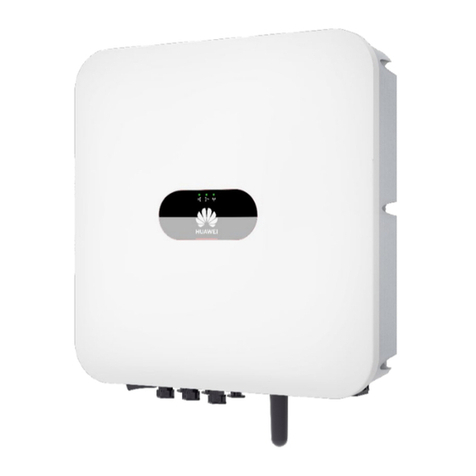
Huawei
Huawei SUN2000-(2KTL-6KTL)-L1 user manual

Carbest
Carbest 82285 User instruction
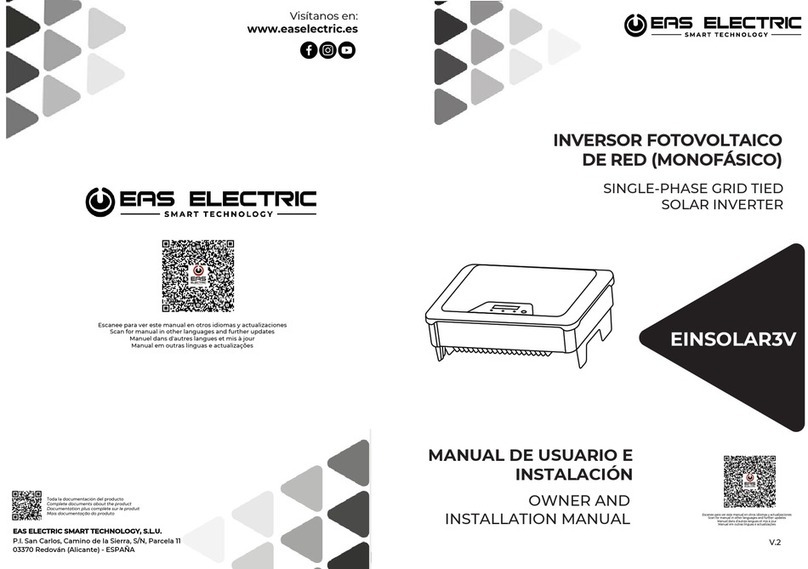
EAS Electric
EAS Electric EINSOLAR3V Owners and installation manual
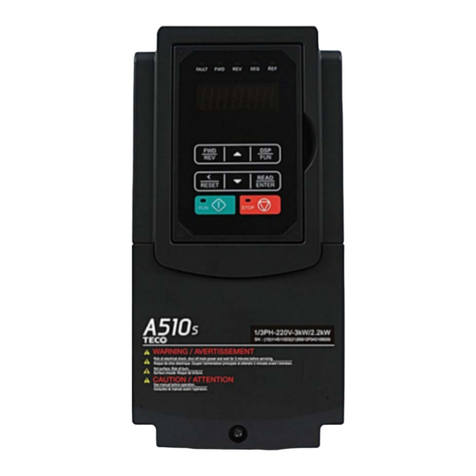
TECO
TECO A510s instruction manual
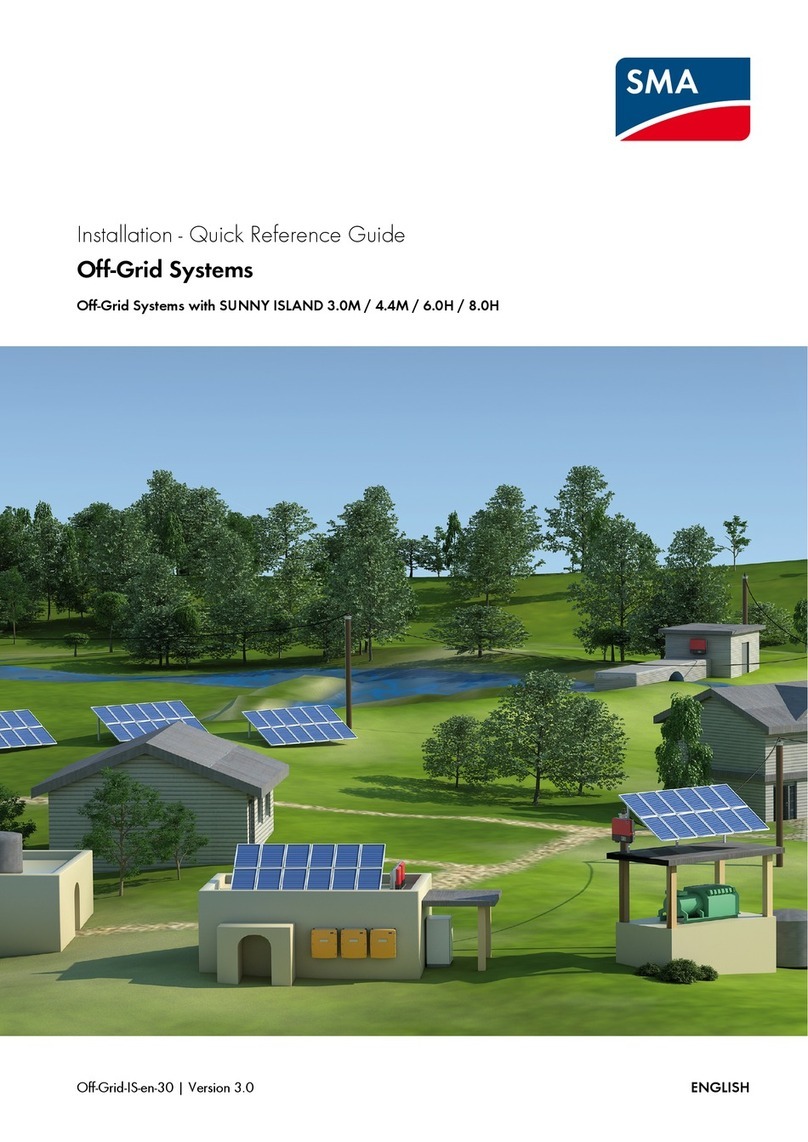
SMA
SMA SUNNY ISLAND 3.0M Installation and quick reference guide




